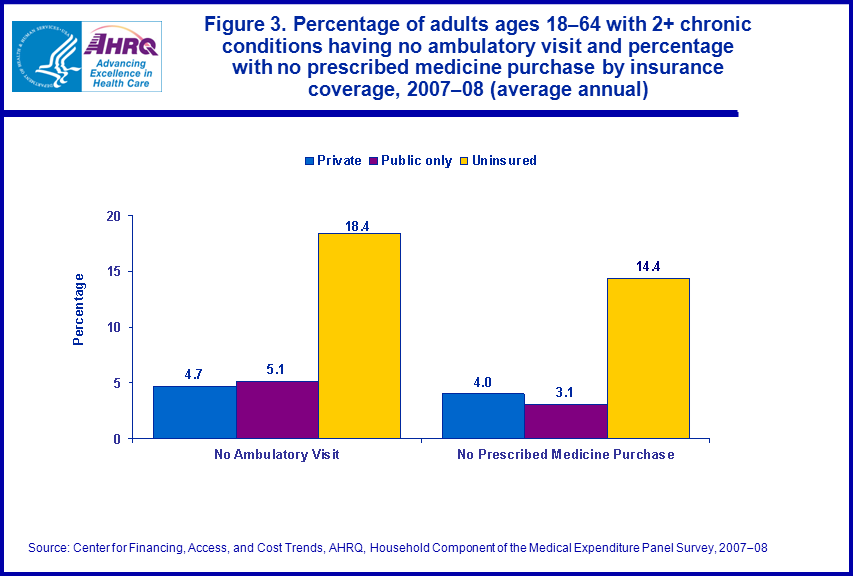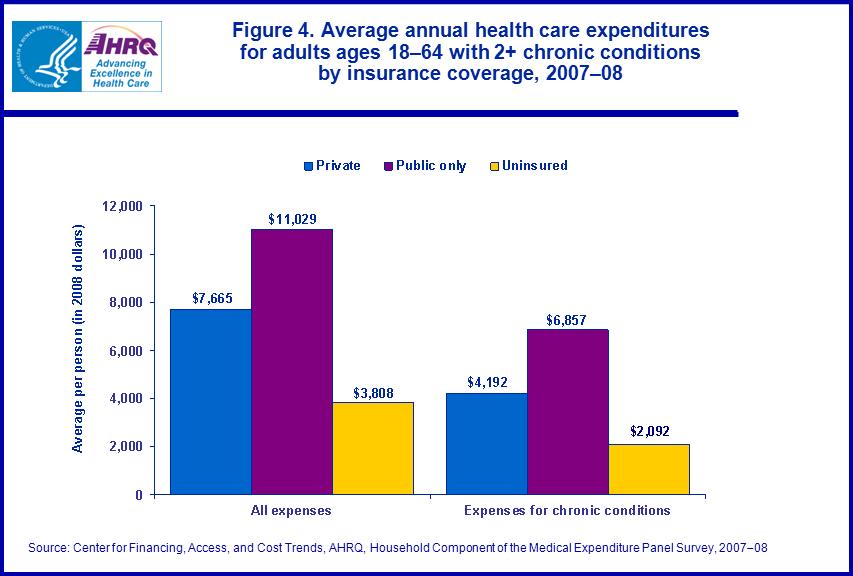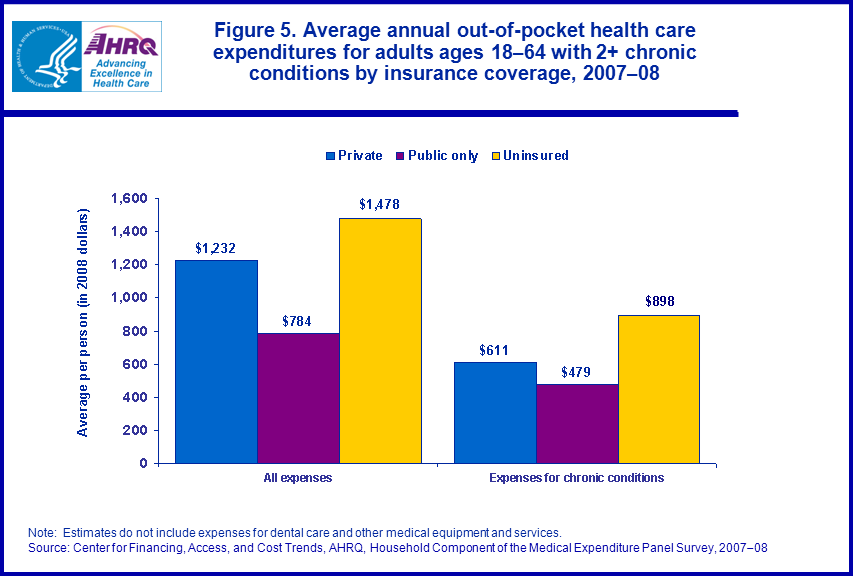
|
|
Font Size:
|
||||
|
|
|
|
||||
STATISTICAL BRIEF #320:
Health Care Access and Expenditures among Non-Elderly Adults with Multiple Chronic Conditions: Variations by Insurance Coverage Status, 2007-08 (Average Annual)
Highlights
- In 2007-08 about 16 percent of uninsured adults had two or more chronic conditions compared to one-third of those with private insurance and nearly half of those with public insurance only.
- A substantially larger proportion of high risk uninsured non-elderly adults than their counterparts with insurance coverage did not have a usual source of health care.
- Uninsured adults with multiple chronic conditions were much more likely to have no ambulatory visits or prescribed medicine purchases than their counterparts with private or public insurance.
- Among non-elderly adults with two or more chronic conditions, average annual health care expenses were highest for those with public insurance and lowest for the uninsured. Conversely, out-of-pocket expenses were higher for the uninsured and those with private coverage than for those with public insurance.
- Family out-of-pocket expenses for all health care comprised an average of about 12 percent of family income for uninsured non-elderly adults with multiple chronic conditions.
Introduction
Health insurance helps people get timely access to medical care and protects them against the risk of unanticipated costly medical events. Persons with a high risk of needing ongoing care, such as those with chronic illnesses that are expensive to treat, have historically had difficulty obtaining private health insurance because of issues related to availability and/or cost. The Patient Protection and Affordable Care Act (PPACA) of 2010 establishes a temporary national high risk pool program designed to provide greater access to health insurance for many of these individuals. Beginning in 2014, the PPACA prohibits denial of insurance to people with pre-existing conditions.This Statistical Brief provides baseline pre-PPACA estimates of health care access, utilization, and expenditures for uninsured high risk non-elderly adults and their counterparts with insurance coverage. High risk individuals are defined here as those with two or more chronic conditions which are defined as conditions expected to last at least one year and result in limitations of self-care, independent living, and social interactions, or the need for ongoing medical intervention (Perrin et al., 1993; Hwang et al., 2001).
The estimates presented are based on pooled annual data for 2007-08 from the Medical Expenditure Panel Survey (MEPS) on adults ages 18-64 in the U.S. civilian noninstitutionalized population. Health care expenses in MEPS represent payments from all sources (e.g., out of pocket, private insurance, Medicare, Medicaid, etc.) for health care services reported by respondents to the MEPS Household Component (MEPS-HC). Data for two years were combined to improve the statistical precision of the estimates. The average annual expenditure estimates for 2007-08 are expressed in 2008 dollars with 2007 data inflated based on the Personal Health Care Price Index (http://www.meps.ahrq.gov/mepsweb/about_meps/Price_Index.shtml). All differences between estimates described in the text are statistically significant at the 0.05 level or better.
Findings
In 2007-08, almost two-thirds of uninsured non-elderly adults had no reported chronic condition as compared to 42.9 percent of those with private insurance and 35.2 percent of those with public insurance only. Conversely, about 16.0 percent of uninsured adults had two or more chronic conditions as compared to one-third of those with private insurance and nearly half (45.1 percent) of those with public insurance only (figure 1). Estimates on access and health care expenditures for individuals with two or more chronic conditions are presented below.Over one-quarter of uninsured non-elderly adults with two or more chronic conditions did not have a usual source of care compared to only 12.1 percent of those with public insurance and 8.7 percent of those with private insurance (figure 2). In addition, uninsured adults with multiple chronic conditions were much more likely to have no ambulatory visits (18.4 percent) or no prescribed medicine purchases (14.4 percent) than their counterparts with insurance (figure 3). Among those with public or private insurance, around 5 percent at most did not receive these types of services.
Total and out-of-pocket expenses by insurance coverage
Among persons ages 18-64 with two or more chronic conditions, average annual health care expenses were highest for those with public insurance ($11,029) and lowest for the uninsured ($3,808) (figure 4). Similarly, average expenses for care associated with chronic conditions were highest for those with public insurance ($6,857) and lowest for the uninsured ($2,092).
Out-of-pocket expenses among those with multiple chronic conditions were higher for the uninsured and those with private coverage than for those with public insurance (figure 5). More specifically, average annual out-of-pocket expenses for the uninsured were nearly double that for those with public insurance--$1,478 versus $784 for all care and $898 versus $479 for care associated with chronic conditions.
Burden of out-of-pocket expenses by insurance coverage
For uninsured non-elderly adults with multiple chronic conditions, family out-of-pocket expenses for all health care comprised an average of about 12 percent of family income while the out-of-pocket expenses associated with treatment of chronic conditions accounted for an average of 7 percent (figure 6).
Data Source
The estimates in this Statistical Brief are based on data from the 2007 and 2008 Full Year Consolidated Data File (HC-113 and HC-121 respectively) and 2007 and 2008 Event Level Files that can be linked to condition data (HC-110A and HC-110D--H in 2007 and HC-118A and HC-118D--H in 2008). The definition of chronic conditions (see below) is based on 5 digit ICD-9-CM codes which are not available on public use files but can be accessed in the AHRQ Data Center.Definitions
Chronic conditionsThe identification of sample persons with two or more chronic conditions was based on application of the AHRQ Healthcare Utilization Project Chronic Condition Indicator (CCI) (http://www.hcup-us.ahrq.gov/toolssoftware/chronic/chronic.jsp#overview) and Clinical Classification Software (http://www.hcup-us.ahrq.gov/toolssoftware/ccs/ccs.jsp) tools to the MEPS medical condition files. These files contain coded information on conditions reported by MEPS respondents as being associated with medical events, disability days and/or were bothersome during the year (http://www.meps.ahrq.gov/mepsweb/data_stats/download_data_files_detail.jsp?cboPufNumber=HC-120).
The CCI categorizes all ICD-9-CM diagnosis codes as chronic or not chronic, with chronic conditions defined as those lasting 12 months or longer that also place limitations on self-care, independent living, and social interactions or result in the need for ongoing intervention with medical products, services, and special equipment (Perrin et al., 1993). The CCI algorithm originated with work by a physician panel that reviewed diagnosis codes appearing in MEPS data (Hwang et al., 2001).
Insurance coverage
Persons were classified into three insurance categories as follows:
- 1) Private: Person had any private insurance coverage (including TRICARE) any time during year.
2) Public only: Person had only public insurance coverage for all or part of year.
3) Uninsured: Person was uninsured all of year.
For each individual family member, the survey ascertains whether there is a particular doctor's office, clinic, health center, or other place that the individual usually goes to if he/she is sick or needs advice about his/her health. The question was asked in Rounds 2 and 4 only.
Expenditures
Expenditures are defined as payments from all sources for hospital inpatient care, ambulatory care provided in offices and hospital outpatient departments, care provided in emergency departments, home health care, dental care, prescribed medicine purchases reported by respondents in the MEPS-HC and various other miscellaneous services. Sources of payment include direct payments from individuals (i.e., out of pocket), private insurance, Medicare, Medicaid, Workers' Compensation, and miscellaneous other sources. Expenditure data for 2007 were adjusted to 2008 dollars using the Personal Health Care Price Index produced by the Office of the Actuary, Centers for Medicare & Medicaid Services (http://www.meps.ahrq.gov/mepsweb/about_meps/Price_Index.shtml).
Chronic condition expenditures are based on medical events associated with chronic conditions including those where it was reported that a non-chronic condition was also treated (see definition above). Expenses for dental care and medical equipment and supplies are included in the total but do not have the potential to be considered chronic expenses because they are not linked to specific conditions in the survey.
Family income
Family income was derived by constructing person-level total income comprising annual earnings from wages, salaries, bonuses, tips, commissions; business and farm gains and losses; unemployment and workers' compensation; interest and dividends; alimony, child support, and other private cash transfers; private pensions, IRA withdrawals, social security, and veterans payments; supplemental security income and cash welfare payments from public assistance, Temporary Assistance for Needy Families, and related programs; gains or losses from estates, trusts, partnerships, S corporations, rent, and royalties; and a small amount of "other" income. Person-level income excluded tax refunds and capital gains. Person-level income totals were summed over family members to yield family-level total income.
About MEPS-HC and MEPS-MPC
The MEPS Household Component (HC) is a nationally representative longitudinal survey that collects detailed information on health care utilization and expenditures, health insurance, and health status, as well as a wide variety of social, demographic, and economic characteristics for the U.S. civilian noninstitutionalized population. It is cosponsored by the Agency for Healthcare Research and Quality and the National Center for Health Statistics.The MEPS Medical Provider Component (MPC) collects information on dates of visit, diagnoses and procedures, and charges and payments from a sample of medical providers who provided care to persons in the survey. The MPC data collected are generally used as the primary source of MEPS expenditure data and are also used to impute expenditure information not reported by household respondents.
For more information about MEPS, call the MEPS information coordinator at AHRQ (301) 427-1406 or visit the MEPS Web site at http://www.meps.ahrq.gov.
References
Cohen, J. Design and Methods of the Medical Expenditure Panel Survey Household Component. MEPS Methodology Report No. 1. AHCPR Pub. No. 97-0026. Rockville, MD: Agency for Healthcare Policy and Research, 1997. http://www.meps.ahrq.gov/mepsweb/data_files/publications/mr1/mr1.shtmlEzzati-Rice, T.M., Rohde, F., Greenblatt, J. Sample Design of the Medical Expenditure Panel Survey Household Component, 1998-2007. Methodology Report No. 22. March 2008. Agency for Healthcare Research and Quality, Rockville, MD. http://www.meps.ahrq.gov/mepsweb/data_files/publications/mr22/mr22.shtml
Hwang, W., Weller, W., Ireys, H., Anderson, G. "Out-of-Pocket Medical Spending for Care of Chronic Conditions," Health Affairs, vol. 20, November/December 2001.
Machlin, S., Cohen, J. and Beauregard, K. Health Care Expenses for Adults with Chronic Conditions, 2005. Statistical Brief #203. May 2008. Agency for Healthcare Research and Quality, Rockville, MD. http://www.meps.ahrq.gov/mepsweb/data_files/publications/st203/stat203.shtml
Perrin, E.C., Newacheck, P., Pless, I.B., Drotar, D., Gortmaker, S.L., Leventhal, J., Perrin, J.M., Stein, R.E., Walker, D.K., Weitzman, M. "Issues Involved in the Definition and Classification of Chronic Health Conditions," Pediatrics. 1993; 91: 787-793.
Suggested Citation
Machlin, S., Cohen, S., and Yu, W. Health Care Access and Expenditures among Non-Elderly Adults with Multiple Chronic Conditions: Variations by Insurance Coverage Status, 2007-08 (Average Annual). Statistical Brief #320. April 2011. Agency for Healthcare Research and Quality, Rockville, MD. http://www.meps.ahrq.gov/mepsweb/data_files/publications/st320/stat320.shtmlAHRQ welcomes questions and comments from readers of this publication who are interested in obtaining more information about access, cost, use, financing, and quality of health care in the United States. We also invite you to tell us how you are using this Statistical Brief and other MEPS data and tools and to share suggestions on how MEPS products might be enhanced to further meet your needs. Please e-mail us at mepspd@ahrq.gov or send a letter to the address below:
Steven B. Cohen, PhD, Director
Center for Financing, Access, and Cost Trends
Agency for Healthcare Research and Quality
540 Gaither Road
Rockville, MD 20850
 |
||||||||||||||||||||||||||||||
|
||||||||||||||||||||||||||||||
|
|
||||||||||||||||||||||||||||||
 |
||||||||||||||||||||||||||||||
|
||||||||||||||||||||||||||||||
|
|
||||||||||||||||||||||||||||||
 |
||||||||||||||||||||||||||||||
|
||||||||||||||||||||||||||||||
|
|
||||||||||||||||||||||||||||||
 |
||||||||||||||||||||||||||||||
|
||||||||||||||||||||||||||||||
|
|
||||||||||||||||||||||||||||||
 |
||||||||||||||||||||||||||||||
|
||||||||||||||||||||||||||||||
|
|
||||||||||||||||||||||||||||||
 |
||||||||||||||||||||||||||||||
|
||||||||||||||||||||||||||||||
|
|
||||||||||||||||||||||||||||||


